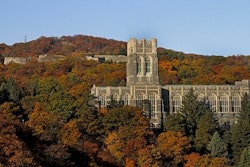Presidents of U.S. public colleges and universities saw their earnings climb by 5.3 percent last year, with several of them topping $1 million, according to an annual survey.
The Chronicle of Higher Education’s study of more than 150 college presidents found that their average annual pay increased in fiscal year 2016 to $501,000.
Among the top earners were eight public university presidents whose total compensation exceeded $1 million, up from five the year before, the study found. Most of them come from the nation’s largest schools and university systems.
Topping the Chronicle’s salary ranking was Arizona State University’s president, Michael Crow, who received almost $1.6 million last year. Along with a base salary of $838,000, he received an annual bonus of $150,000 and a 10-year retention bonus of $550,000 paid by the university’s private foundation.
Arizona State officials noted that Crow’s retention bonus was a one-time payment and that he was eligible for an additional $900,000 that instead went to the university’s Public Service Academy.
The Arizona Board of Regents, the governing body of Arizona State, called Crow “a remarkable leader of the highest caliber” and said he has boosted student success and the state’s economy.
“Under President Crow’s leadership, the four-year graduation rate for Arizona residents has nearly doubled since 2002 and research expenditures are on a strong trajectory of growth, having nearly quadrupled during the same time,” board vice chair Bill Ridenour said by email.
Following Crow were the chancellor of the University of Texas System, William McRaven, and the chancellor of the Texas A&M University System, John Sharp.
The survey found that two presidents received base salaries of $1 million or more last year, a threshold that had no public university chief had previously crossed in the study’s history.
McRaven’s $1.5 million pay package included a base salary of $1.2 million, and the president of Texas A&M’s College Station campus, Michael Young, was paid $1 million that was entirely base pay. The previous highest salary was $851,000, given by Ohio State University in 2013.
The chairman of the University of Texas System’s governing board, Paul Foster, said McRaven’s pay is “reasonable and justified” and comes from private donations.
“Our Chancellor is essentially the CEO of one of the largest and most complex organizations in the state of Texas and one of the largest systems of higher education in the country,” Foster said in a statement. “He is well recognized as a great leader and manager, and in my opinion, earns every cent.”
The Chronicle changed its methodology for total compensation in this year’s survey to include nontaxable benefits such as medical insurance and legal services. Using its previous formula, it found that pay for public university presidents increased 4.3 percent in 2015 and 7 percent in 2014.
Public university executives are typically paid less than their counterparts at private universities, whose salaries are gathered separately by The Chronicle. According to the latest study of private colleges, which used data from 2014, almost 40 colleges paid their chiefs at least $1 million, led by $5.4 million at Wilmington University in Delaware.
Colleges of all types have faced pressure to rein in spending in recent years as costs for students continue to rise, and some critics say salaries and benefits for presidents have become lavish. Many colleges counter that they have to pay competitively to hire quality leaders and that even the highest salaries are only a small fraction of overall budgets.


















